Report: Analysis of Business Environment, Tesco, NHS, and Oxfam
VerifiedAdded on 2023/01/12
|20
|6279
|21
Report
AI Summary
This report analyzes the business environments of three organizations: Tesco (private), NHS (public), and Oxfam (voluntary). It begins with an introduction and comparison of their types, legal structures, sizes, and scopes, using a table to highlight key differences. The report then delves into the purpose and legal structures of each organization, examining their stakeholders. It explores organizational functions, the interrelation among them, and how they contribute to achieving objectives. Furthermore, the report includes external and internal analyses using PESTLE and SWOT frameworks, respectively, and examines the interrelation of strengths and weaknesses with external factors. The report concludes with an overview of how internal analysis influences organizational performance and the relationship between strengths, weaknesses, and macro-environmental factors.
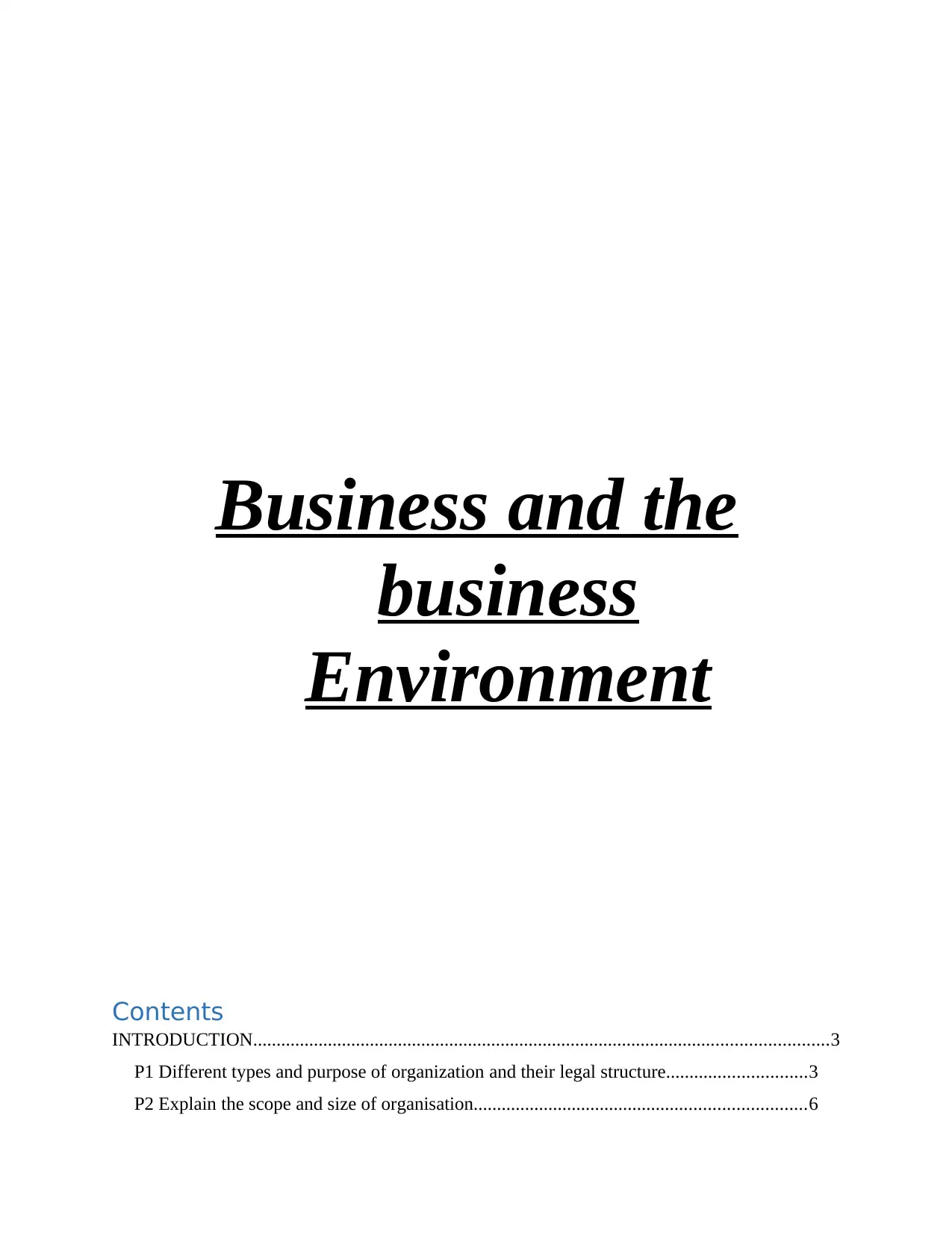
Business and the
business
Environment
Contents
INTRODUCTION...........................................................................................................................3
P1 Different types and purpose of organization and their legal structure..............................3
P2 Explain the scope and size of organisation.......................................................................6
business
Environment
Contents
INTRODUCTION...........................................................................................................................3
P1 Different types and purpose of organization and their legal structure..............................3
P2 Explain the scope and size of organisation.......................................................................6
Paraphrase This Document
Need a fresh take? Get an instant paraphrase of this document with our AI Paraphraser
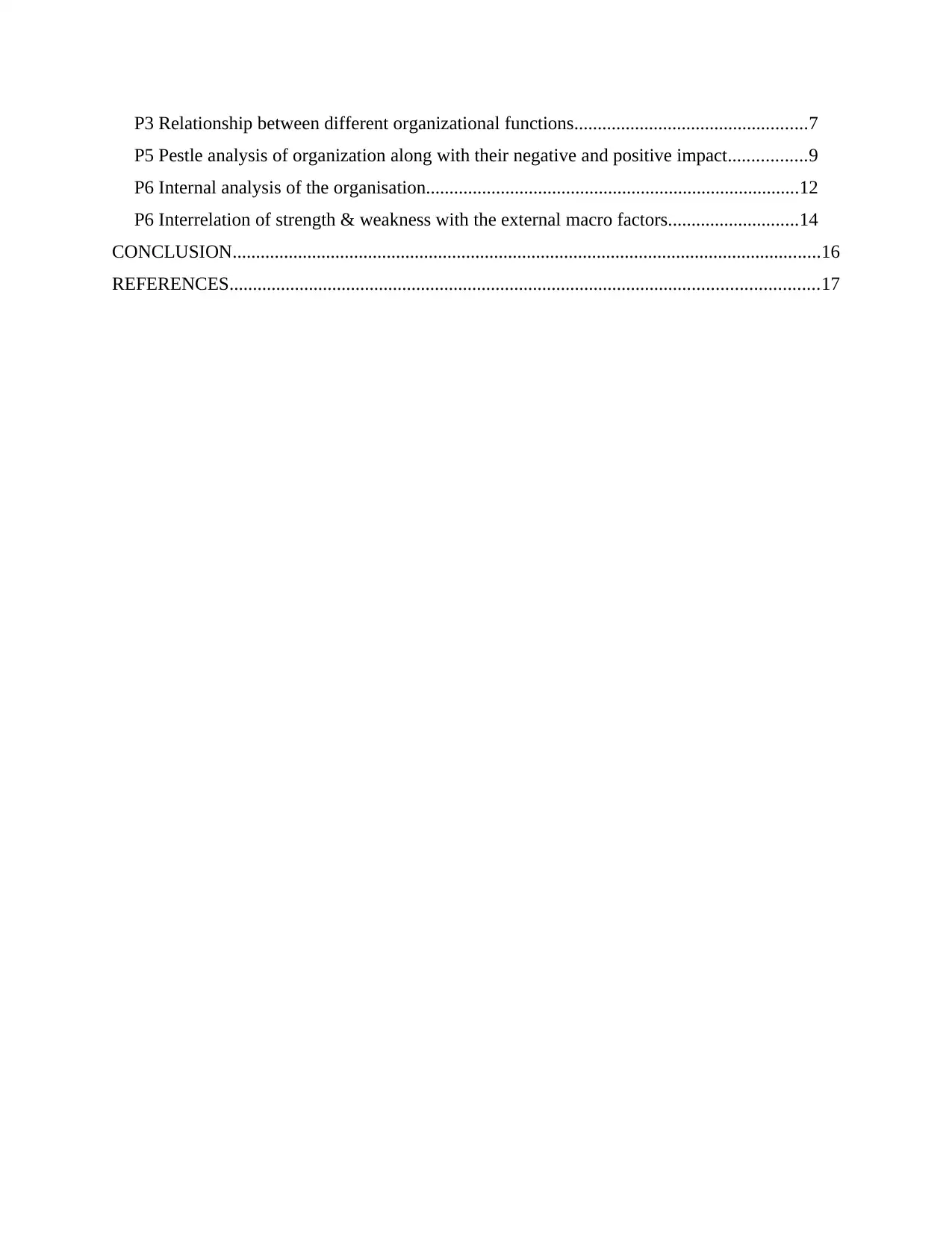
P3 Relationship between different organizational functions..................................................7
P5 Pestle analysis of organization along with their negative and positive impact.................9
P6 Internal analysis of the organisation................................................................................12
P6 Interrelation of strength & weakness with the external macro factors............................14
CONCLUSION..............................................................................................................................16
REFERENCES..............................................................................................................................17
P5 Pestle analysis of organization along with their negative and positive impact.................9
P6 Internal analysis of the organisation................................................................................12
P6 Interrelation of strength & weakness with the external macro factors............................14
CONCLUSION..............................................................................................................................16
REFERENCES..............................................................................................................................17
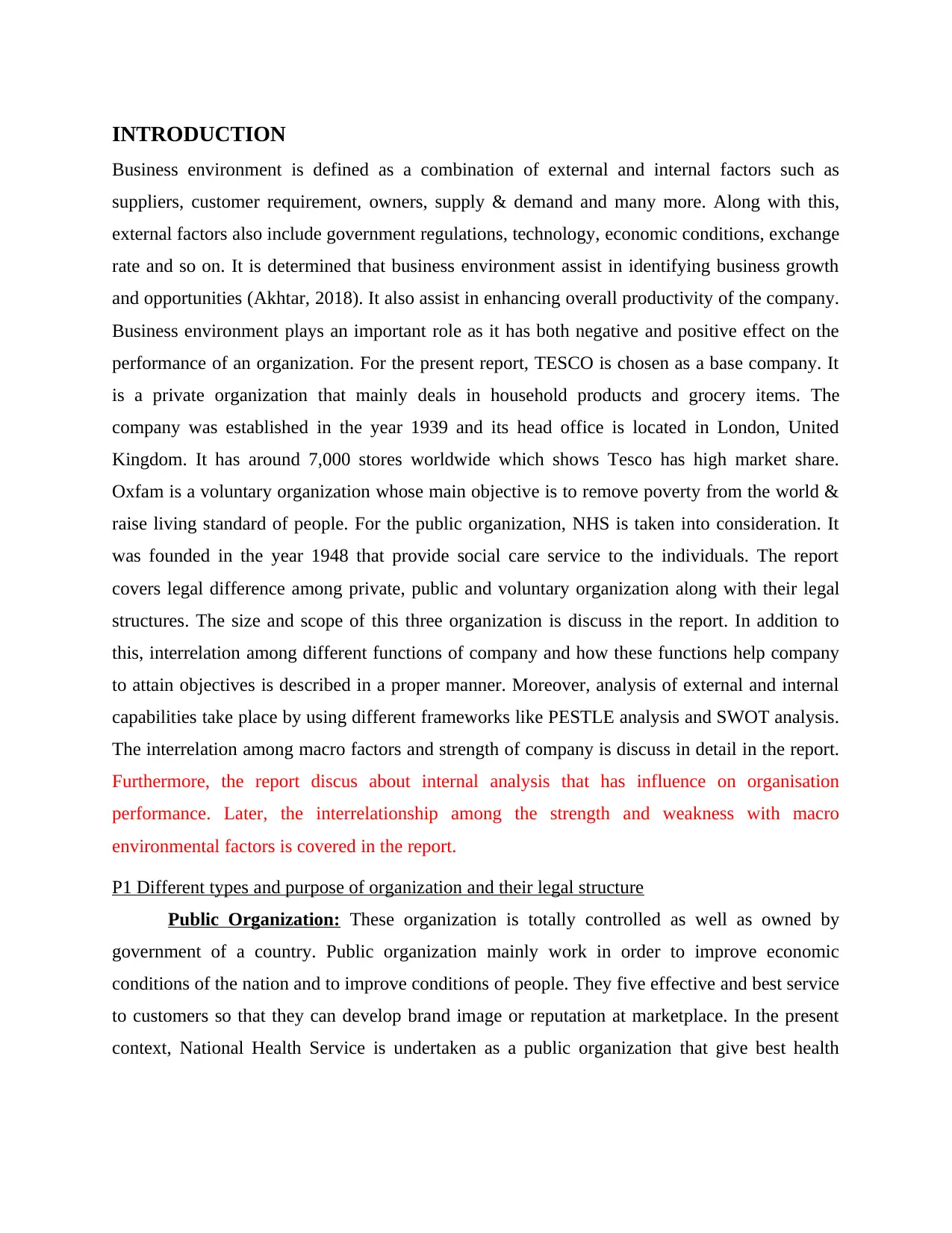
INTRODUCTION
Business environment is defined as a combination of external and internal factors such as
suppliers, customer requirement, owners, supply & demand and many more. Along with this,
external factors also include government regulations, technology, economic conditions, exchange
rate and so on. It is determined that business environment assist in identifying business growth
and opportunities (Akhtar, 2018). It also assist in enhancing overall productivity of the company.
Business environment plays an important role as it has both negative and positive effect on the
performance of an organization. For the present report, TESCO is chosen as a base company. It
is a private organization that mainly deals in household products and grocery items. The
company was established in the year 1939 and its head office is located in London, United
Kingdom. It has around 7,000 stores worldwide which shows Tesco has high market share.
Oxfam is a voluntary organization whose main objective is to remove poverty from the world &
raise living standard of people. For the public organization, NHS is taken into consideration. It
was founded in the year 1948 that provide social care service to the individuals. The report
covers legal difference among private, public and voluntary organization along with their legal
structures. The size and scope of this three organization is discuss in the report. In addition to
this, interrelation among different functions of company and how these functions help company
to attain objectives is described in a proper manner. Moreover, analysis of external and internal
capabilities take place by using different frameworks like PESTLE analysis and SWOT analysis.
The interrelation among macro factors and strength of company is discuss in detail in the report.
Furthermore, the report discus about internal analysis that has influence on organisation
performance. Later, the interrelationship among the strength and weakness with macro
environmental factors is covered in the report.
P1 Different types and purpose of organization and their legal structure
Public Organization: These organization is totally controlled as well as owned by
government of a country. Public organization mainly work in order to improve economic
conditions of the nation and to improve conditions of people. They five effective and best service
to customers so that they can develop brand image or reputation at marketplace. In the present
context, National Health Service is undertaken as a public organization that give best health
Business environment is defined as a combination of external and internal factors such as
suppliers, customer requirement, owners, supply & demand and many more. Along with this,
external factors also include government regulations, technology, economic conditions, exchange
rate and so on. It is determined that business environment assist in identifying business growth
and opportunities (Akhtar, 2018). It also assist in enhancing overall productivity of the company.
Business environment plays an important role as it has both negative and positive effect on the
performance of an organization. For the present report, TESCO is chosen as a base company. It
is a private organization that mainly deals in household products and grocery items. The
company was established in the year 1939 and its head office is located in London, United
Kingdom. It has around 7,000 stores worldwide which shows Tesco has high market share.
Oxfam is a voluntary organization whose main objective is to remove poverty from the world &
raise living standard of people. For the public organization, NHS is taken into consideration. It
was founded in the year 1948 that provide social care service to the individuals. The report
covers legal difference among private, public and voluntary organization along with their legal
structures. The size and scope of this three organization is discuss in the report. In addition to
this, interrelation among different functions of company and how these functions help company
to attain objectives is described in a proper manner. Moreover, analysis of external and internal
capabilities take place by using different frameworks like PESTLE analysis and SWOT analysis.
The interrelation among macro factors and strength of company is discuss in detail in the report.
Furthermore, the report discus about internal analysis that has influence on organisation
performance. Later, the interrelationship among the strength and weakness with macro
environmental factors is covered in the report.
P1 Different types and purpose of organization and their legal structure
Public Organization: These organization is totally controlled as well as owned by
government of a country. Public organization mainly work in order to improve economic
conditions of the nation and to improve conditions of people. They five effective and best service
to customers so that they can develop brand image or reputation at marketplace. In the present
context, National Health Service is undertaken as a public organization that give best health
⊘ This is a preview!⊘
Do you want full access?
Subscribe today to unlock all pages.

Trusted by 1+ million students worldwide
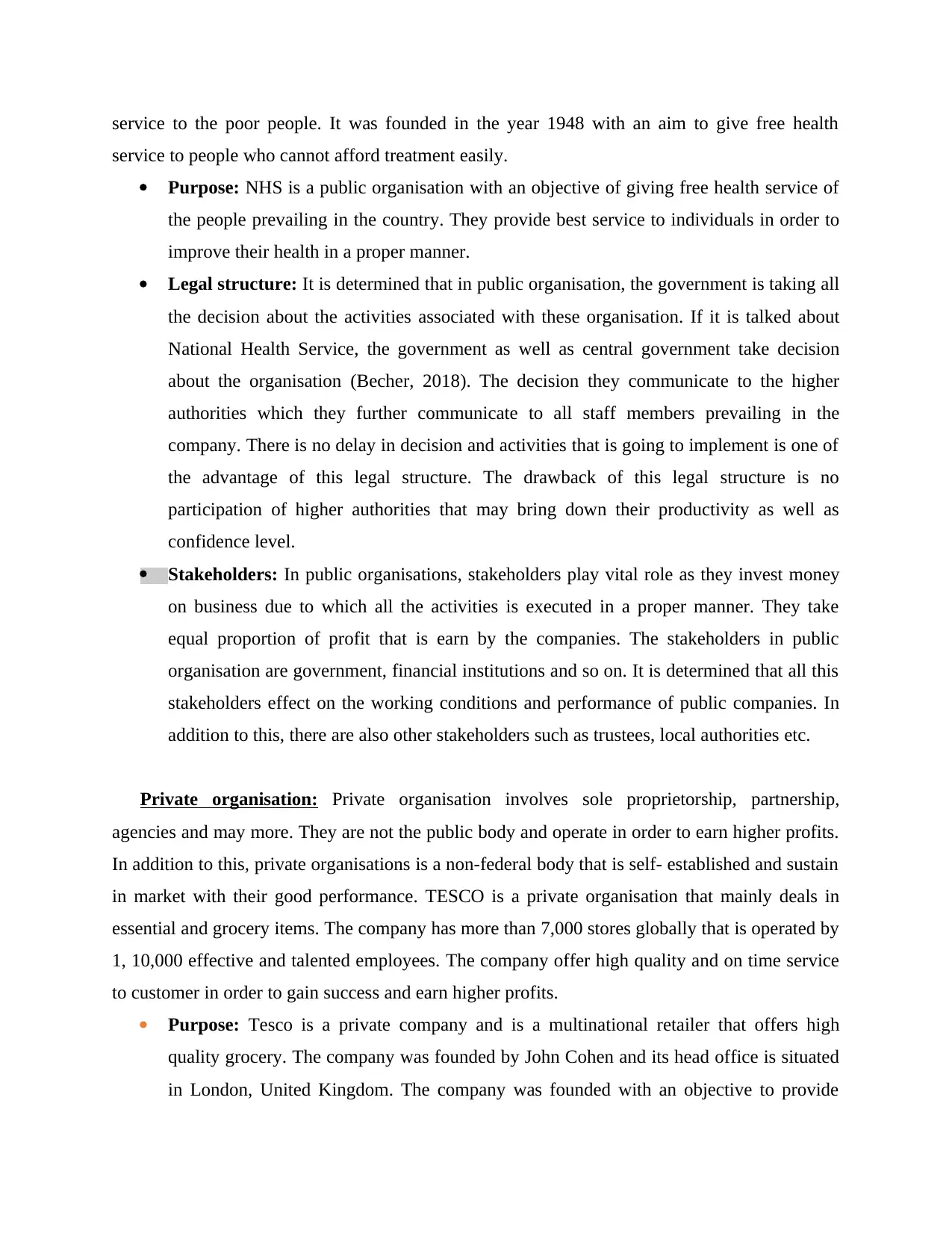
service to the poor people. It was founded in the year 1948 with an aim to give free health
service to people who cannot afford treatment easily.
Purpose: NHS is a public organisation with an objective of giving free health service of
the people prevailing in the country. They provide best service to individuals in order to
improve their health in a proper manner.
Legal structure: It is determined that in public organisation, the government is taking all
the decision about the activities associated with these organisation. If it is talked about
National Health Service, the government as well as central government take decision
about the organisation (Becher, 2018). The decision they communicate to the higher
authorities which they further communicate to all staff members prevailing in the
company. There is no delay in decision and activities that is going to implement is one of
the advantage of this legal structure. The drawback of this legal structure is no
participation of higher authorities that may bring down their productivity as well as
confidence level.
Stakeholders: In public organisations, stakeholders play vital role as they invest money
on business due to which all the activities is executed in a proper manner. They take
equal proportion of profit that is earn by the companies. The stakeholders in public
organisation are government, financial institutions and so on. It is determined that all this
stakeholders effect on the working conditions and performance of public companies. In
addition to this, there are also other stakeholders such as trustees, local authorities etc.
Private organisation: Private organisation involves sole proprietorship, partnership,
agencies and may more. They are not the public body and operate in order to earn higher profits.
In addition to this, private organisations is a non-federal body that is self- established and sustain
in market with their good performance. TESCO is a private organisation that mainly deals in
essential and grocery items. The company has more than 7,000 stores globally that is operated by
1, 10,000 effective and talented employees. The company offer high quality and on time service
to customer in order to gain success and earn higher profits.
Purpose: Tesco is a private company and is a multinational retailer that offers high
quality grocery. The company was founded by John Cohen and its head office is situated
in London, United Kingdom. The company was founded with an objective to provide
service to people who cannot afford treatment easily.
Purpose: NHS is a public organisation with an objective of giving free health service of
the people prevailing in the country. They provide best service to individuals in order to
improve their health in a proper manner.
Legal structure: It is determined that in public organisation, the government is taking all
the decision about the activities associated with these organisation. If it is talked about
National Health Service, the government as well as central government take decision
about the organisation (Becher, 2018). The decision they communicate to the higher
authorities which they further communicate to all staff members prevailing in the
company. There is no delay in decision and activities that is going to implement is one of
the advantage of this legal structure. The drawback of this legal structure is no
participation of higher authorities that may bring down their productivity as well as
confidence level.
Stakeholders: In public organisations, stakeholders play vital role as they invest money
on business due to which all the activities is executed in a proper manner. They take
equal proportion of profit that is earn by the companies. The stakeholders in public
organisation are government, financial institutions and so on. It is determined that all this
stakeholders effect on the working conditions and performance of public companies. In
addition to this, there are also other stakeholders such as trustees, local authorities etc.
Private organisation: Private organisation involves sole proprietorship, partnership,
agencies and may more. They are not the public body and operate in order to earn higher profits.
In addition to this, private organisations is a non-federal body that is self- established and sustain
in market with their good performance. TESCO is a private organisation that mainly deals in
essential and grocery items. The company has more than 7,000 stores globally that is operated by
1, 10,000 effective and talented employees. The company offer high quality and on time service
to customer in order to gain success and earn higher profits.
Purpose: Tesco is a private company and is a multinational retailer that offers high
quality grocery. The company was founded by John Cohen and its head office is situated
in London, United Kingdom. The company was founded with an objective to provide
Paraphrase This Document
Need a fresh take? Get an instant paraphrase of this document with our AI Paraphraser
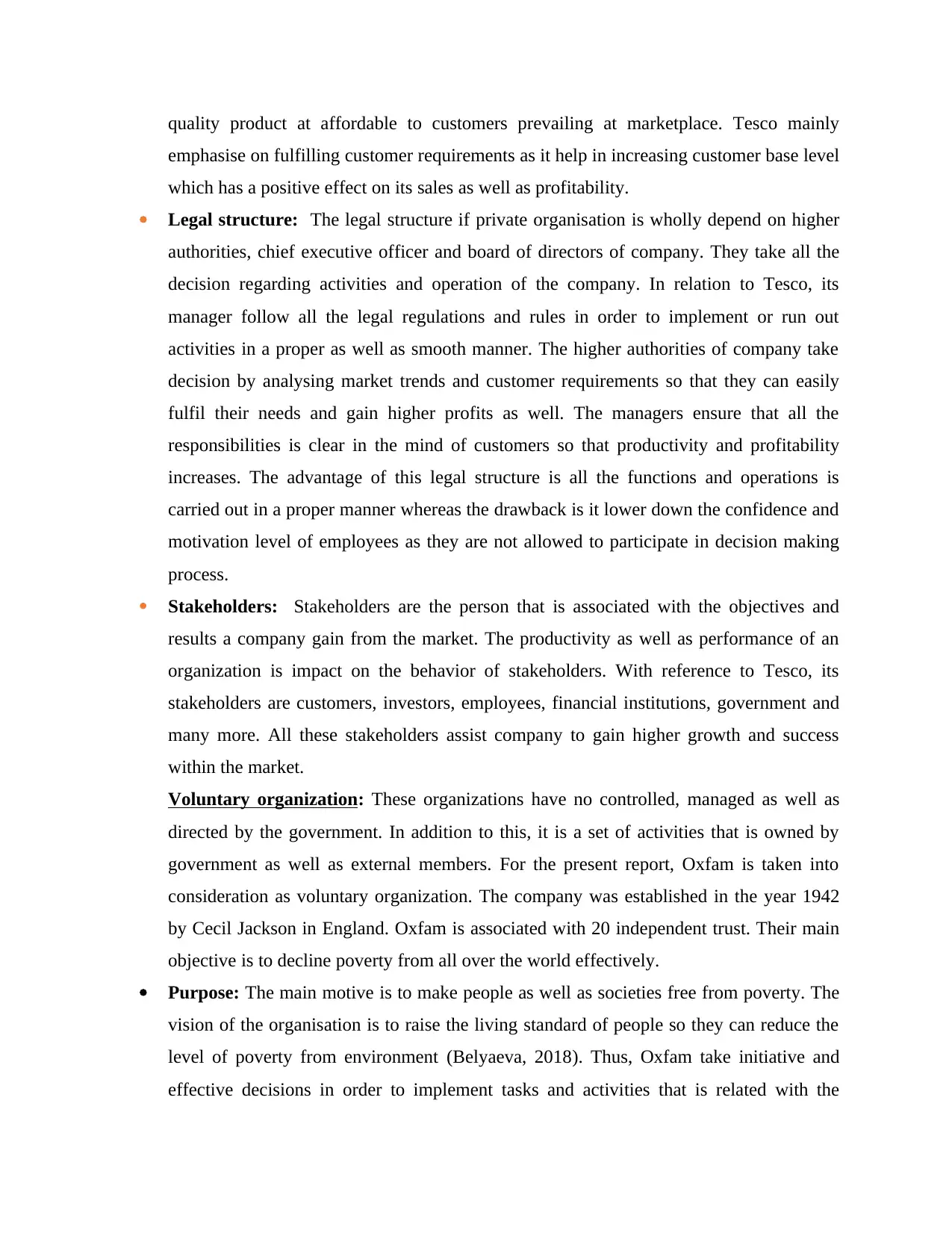
quality product at affordable to customers prevailing at marketplace. Tesco mainly
emphasise on fulfilling customer requirements as it help in increasing customer base level
which has a positive effect on its sales as well as profitability.
Legal structure: The legal structure if private organisation is wholly depend on higher
authorities, chief executive officer and board of directors of company. They take all the
decision regarding activities and operation of the company. In relation to Tesco, its
manager follow all the legal regulations and rules in order to implement or run out
activities in a proper as well as smooth manner. The higher authorities of company take
decision by analysing market trends and customer requirements so that they can easily
fulfil their needs and gain higher profits as well. The managers ensure that all the
responsibilities is clear in the mind of customers so that productivity and profitability
increases. The advantage of this legal structure is all the functions and operations is
carried out in a proper manner whereas the drawback is it lower down the confidence and
motivation level of employees as they are not allowed to participate in decision making
process.
Stakeholders: Stakeholders are the person that is associated with the objectives and
results a company gain from the market. The productivity as well as performance of an
organization is impact on the behavior of stakeholders. With reference to Tesco, its
stakeholders are customers, investors, employees, financial institutions, government and
many more. All these stakeholders assist company to gain higher growth and success
within the market.
Voluntary organization: These organizations have no controlled, managed as well as
directed by the government. In addition to this, it is a set of activities that is owned by
government as well as external members. For the present report, Oxfam is taken into
consideration as voluntary organization. The company was established in the year 1942
by Cecil Jackson in England. Oxfam is associated with 20 independent trust. Their main
objective is to decline poverty from all over the world effectively.
Purpose: The main motive is to make people as well as societies free from poverty. The
vision of the organisation is to raise the living standard of people so they can reduce the
level of poverty from environment (Belyaeva, 2018). Thus, Oxfam take initiative and
effective decisions in order to implement tasks and activities that is related with the
emphasise on fulfilling customer requirements as it help in increasing customer base level
which has a positive effect on its sales as well as profitability.
Legal structure: The legal structure if private organisation is wholly depend on higher
authorities, chief executive officer and board of directors of company. They take all the
decision regarding activities and operation of the company. In relation to Tesco, its
manager follow all the legal regulations and rules in order to implement or run out
activities in a proper as well as smooth manner. The higher authorities of company take
decision by analysing market trends and customer requirements so that they can easily
fulfil their needs and gain higher profits as well. The managers ensure that all the
responsibilities is clear in the mind of customers so that productivity and profitability
increases. The advantage of this legal structure is all the functions and operations is
carried out in a proper manner whereas the drawback is it lower down the confidence and
motivation level of employees as they are not allowed to participate in decision making
process.
Stakeholders: Stakeholders are the person that is associated with the objectives and
results a company gain from the market. The productivity as well as performance of an
organization is impact on the behavior of stakeholders. With reference to Tesco, its
stakeholders are customers, investors, employees, financial institutions, government and
many more. All these stakeholders assist company to gain higher growth and success
within the market.
Voluntary organization: These organizations have no controlled, managed as well as
directed by the government. In addition to this, it is a set of activities that is owned by
government as well as external members. For the present report, Oxfam is taken into
consideration as voluntary organization. The company was established in the year 1942
by Cecil Jackson in England. Oxfam is associated with 20 independent trust. Their main
objective is to decline poverty from all over the world effectively.
Purpose: The main motive is to make people as well as societies free from poverty. The
vision of the organisation is to raise the living standard of people so they can reduce the
level of poverty from environment (Belyaeva, 2018). Thus, Oxfam take initiative and
effective decisions in order to implement tasks and activities that is related with the
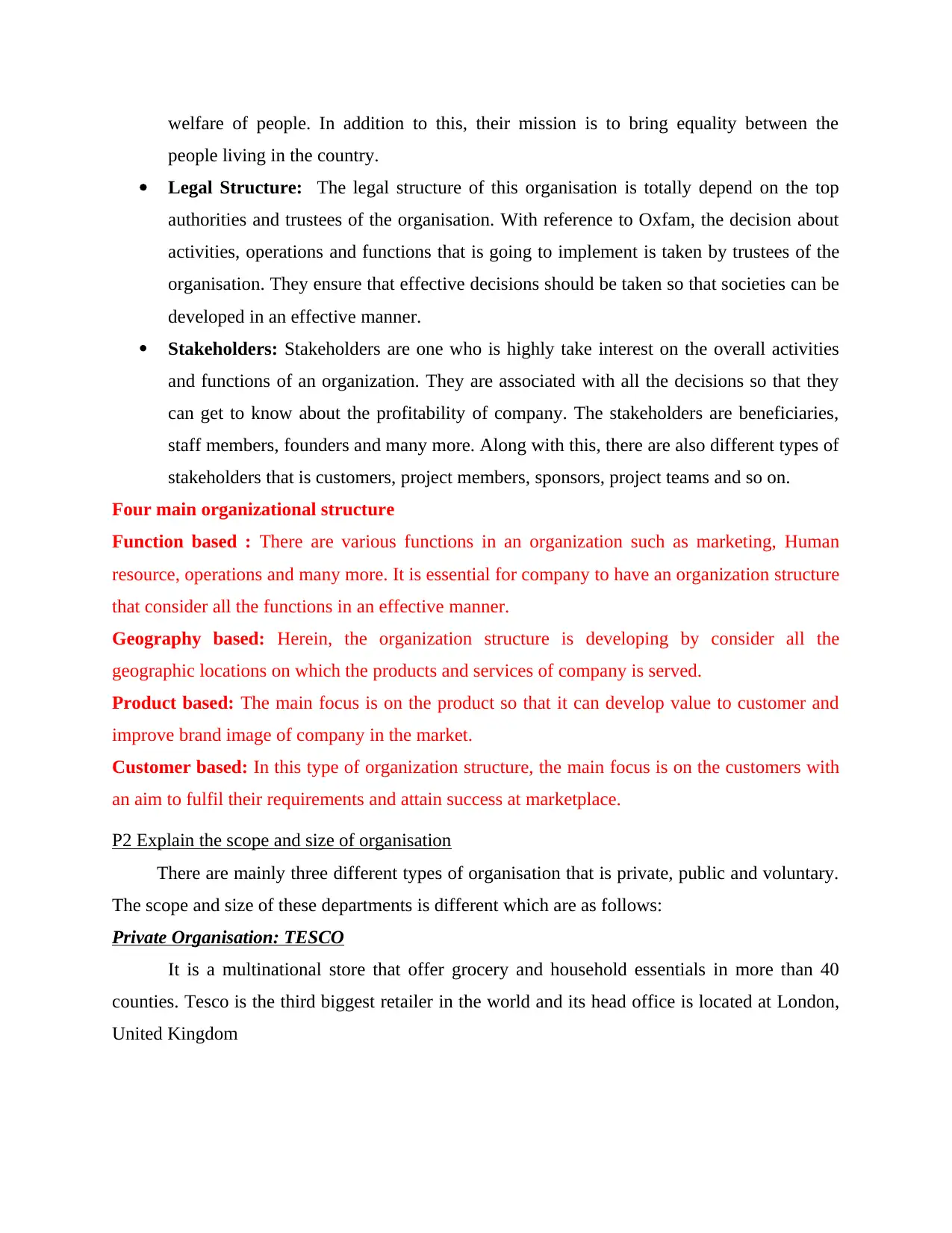
welfare of people. In addition to this, their mission is to bring equality between the
people living in the country.
Legal Structure: The legal structure of this organisation is totally depend on the top
authorities and trustees of the organisation. With reference to Oxfam, the decision about
activities, operations and functions that is going to implement is taken by trustees of the
organisation. They ensure that effective decisions should be taken so that societies can be
developed in an effective manner.
Stakeholders: Stakeholders are one who is highly take interest on the overall activities
and functions of an organization. They are associated with all the decisions so that they
can get to know about the profitability of company. The stakeholders are beneficiaries,
staff members, founders and many more. Along with this, there are also different types of
stakeholders that is customers, project members, sponsors, project teams and so on.
Four main organizational structure
Function based : There are various functions in an organization such as marketing, Human
resource, operations and many more. It is essential for company to have an organization structure
that consider all the functions in an effective manner.
Geography based: Herein, the organization structure is developing by consider all the
geographic locations on which the products and services of company is served.
Product based: The main focus is on the product so that it can develop value to customer and
improve brand image of company in the market.
Customer based: In this type of organization structure, the main focus is on the customers with
an aim to fulfil their requirements and attain success at marketplace.
P2 Explain the scope and size of organisation
There are mainly three different types of organisation that is private, public and voluntary.
The scope and size of these departments is different which are as follows:
Private Organisation: TESCO
It is a multinational store that offer grocery and household essentials in more than 40
counties. Tesco is the third biggest retailer in the world and its head office is located at London,
United Kingdom
people living in the country.
Legal Structure: The legal structure of this organisation is totally depend on the top
authorities and trustees of the organisation. With reference to Oxfam, the decision about
activities, operations and functions that is going to implement is taken by trustees of the
organisation. They ensure that effective decisions should be taken so that societies can be
developed in an effective manner.
Stakeholders: Stakeholders are one who is highly take interest on the overall activities
and functions of an organization. They are associated with all the decisions so that they
can get to know about the profitability of company. The stakeholders are beneficiaries,
staff members, founders and many more. Along with this, there are also different types of
stakeholders that is customers, project members, sponsors, project teams and so on.
Four main organizational structure
Function based : There are various functions in an organization such as marketing, Human
resource, operations and many more. It is essential for company to have an organization structure
that consider all the functions in an effective manner.
Geography based: Herein, the organization structure is developing by consider all the
geographic locations on which the products and services of company is served.
Product based: The main focus is on the product so that it can develop value to customer and
improve brand image of company in the market.
Customer based: In this type of organization structure, the main focus is on the customers with
an aim to fulfil their requirements and attain success at marketplace.
P2 Explain the scope and size of organisation
There are mainly three different types of organisation that is private, public and voluntary.
The scope and size of these departments is different which are as follows:
Private Organisation: TESCO
It is a multinational store that offer grocery and household essentials in more than 40
counties. Tesco is the third biggest retailer in the world and its head office is located at London,
United Kingdom
⊘ This is a preview!⊘
Do you want full access?
Subscribe today to unlock all pages.

Trusted by 1+ million students worldwide
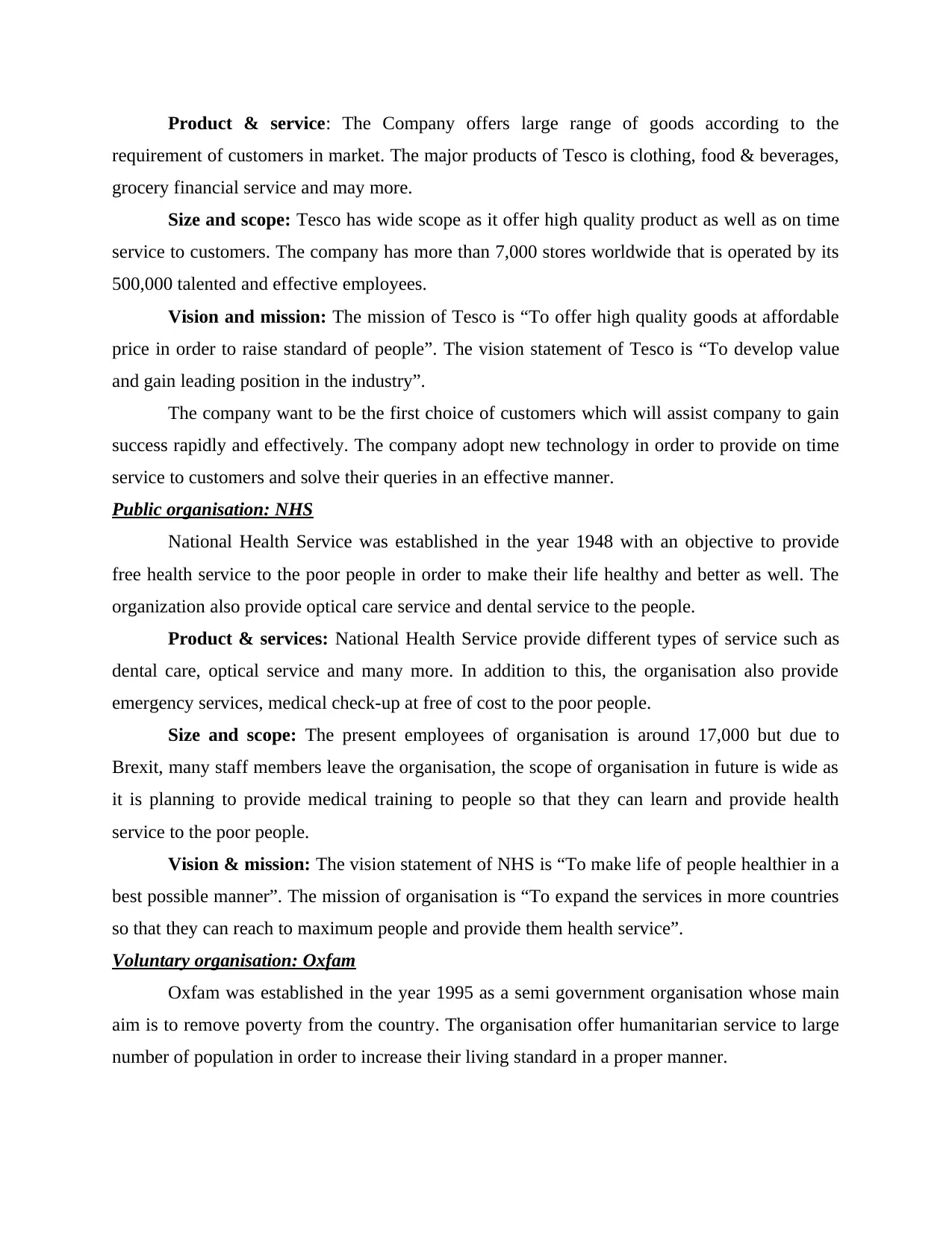
Product & service: The Company offers large range of goods according to the
requirement of customers in market. The major products of Tesco is clothing, food & beverages,
grocery financial service and may more.
Size and scope: Tesco has wide scope as it offer high quality product as well as on time
service to customers. The company has more than 7,000 stores worldwide that is operated by its
500,000 talented and effective employees.
Vision and mission: The mission of Tesco is “To offer high quality goods at affordable
price in order to raise standard of people”. The vision statement of Tesco is “To develop value
and gain leading position in the industry”.
The company want to be the first choice of customers which will assist company to gain
success rapidly and effectively. The company adopt new technology in order to provide on time
service to customers and solve their queries in an effective manner.
Public organisation: NHS
National Health Service was established in the year 1948 with an objective to provide
free health service to the poor people in order to make their life healthy and better as well. The
organization also provide optical care service and dental service to the people.
Product & services: National Health Service provide different types of service such as
dental care, optical service and many more. In addition to this, the organisation also provide
emergency services, medical check-up at free of cost to the poor people.
Size and scope: The present employees of organisation is around 17,000 but due to
Brexit, many staff members leave the organisation, the scope of organisation in future is wide as
it is planning to provide medical training to people so that they can learn and provide health
service to the poor people.
Vision & mission: The vision statement of NHS is “To make life of people healthier in a
best possible manner”. The mission of organisation is “To expand the services in more countries
so that they can reach to maximum people and provide them health service”.
Voluntary organisation: Oxfam
Oxfam was established in the year 1995 as a semi government organisation whose main
aim is to remove poverty from the country. The organisation offer humanitarian service to large
number of population in order to increase their living standard in a proper manner.
requirement of customers in market. The major products of Tesco is clothing, food & beverages,
grocery financial service and may more.
Size and scope: Tesco has wide scope as it offer high quality product as well as on time
service to customers. The company has more than 7,000 stores worldwide that is operated by its
500,000 talented and effective employees.
Vision and mission: The mission of Tesco is “To offer high quality goods at affordable
price in order to raise standard of people”. The vision statement of Tesco is “To develop value
and gain leading position in the industry”.
The company want to be the first choice of customers which will assist company to gain
success rapidly and effectively. The company adopt new technology in order to provide on time
service to customers and solve their queries in an effective manner.
Public organisation: NHS
National Health Service was established in the year 1948 with an objective to provide
free health service to the poor people in order to make their life healthy and better as well. The
organization also provide optical care service and dental service to the people.
Product & services: National Health Service provide different types of service such as
dental care, optical service and many more. In addition to this, the organisation also provide
emergency services, medical check-up at free of cost to the poor people.
Size and scope: The present employees of organisation is around 17,000 but due to
Brexit, many staff members leave the organisation, the scope of organisation in future is wide as
it is planning to provide medical training to people so that they can learn and provide health
service to the poor people.
Vision & mission: The vision statement of NHS is “To make life of people healthier in a
best possible manner”. The mission of organisation is “To expand the services in more countries
so that they can reach to maximum people and provide them health service”.
Voluntary organisation: Oxfam
Oxfam was established in the year 1995 as a semi government organisation whose main
aim is to remove poverty from the country. The organisation offer humanitarian service to large
number of population in order to increase their living standard in a proper manner.
Paraphrase This Document
Need a fresh take? Get an instant paraphrase of this document with our AI Paraphraser
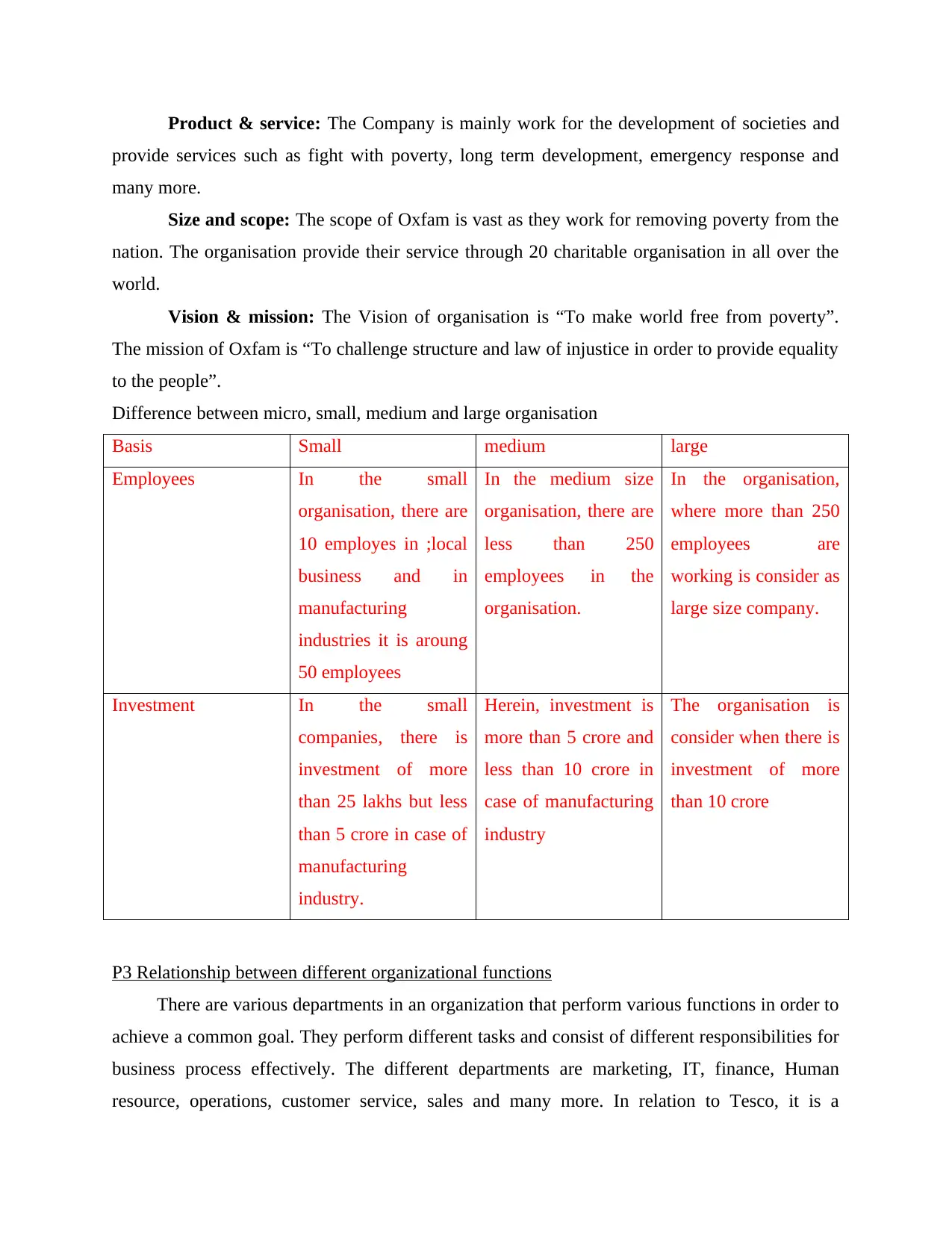
Product & service: The Company is mainly work for the development of societies and
provide services such as fight with poverty, long term development, emergency response and
many more.
Size and scope: The scope of Oxfam is vast as they work for removing poverty from the
nation. The organisation provide their service through 20 charitable organisation in all over the
world.
Vision & mission: The Vision of organisation is “To make world free from poverty”.
The mission of Oxfam is “To challenge structure and law of injustice in order to provide equality
to the people”.
Difference between micro, small, medium and large organisation
Basis Small medium large
Employees In the small
organisation, there are
10 employes in ;local
business and in
manufacturing
industries it is aroung
50 employees
In the medium size
organisation, there are
less than 250
employees in the
organisation.
In the organisation,
where more than 250
employees are
working is consider as
large size company.
Investment In the small
companies, there is
investment of more
than 25 lakhs but less
than 5 crore in case of
manufacturing
industry.
Herein, investment is
more than 5 crore and
less than 10 crore in
case of manufacturing
industry
The organisation is
consider when there is
investment of more
than 10 crore
P3 Relationship between different organizational functions
There are various departments in an organization that perform various functions in order to
achieve a common goal. They perform different tasks and consist of different responsibilities for
business process effectively. The different departments are marketing, IT, finance, Human
resource, operations, customer service, sales and many more. In relation to Tesco, it is a
provide services such as fight with poverty, long term development, emergency response and
many more.
Size and scope: The scope of Oxfam is vast as they work for removing poverty from the
nation. The organisation provide their service through 20 charitable organisation in all over the
world.
Vision & mission: The Vision of organisation is “To make world free from poverty”.
The mission of Oxfam is “To challenge structure and law of injustice in order to provide equality
to the people”.
Difference between micro, small, medium and large organisation
Basis Small medium large
Employees In the small
organisation, there are
10 employes in ;local
business and in
manufacturing
industries it is aroung
50 employees
In the medium size
organisation, there are
less than 250
employees in the
organisation.
In the organisation,
where more than 250
employees are
working is consider as
large size company.
Investment In the small
companies, there is
investment of more
than 25 lakhs but less
than 5 crore in case of
manufacturing
industry.
Herein, investment is
more than 5 crore and
less than 10 crore in
case of manufacturing
industry
The organisation is
consider when there is
investment of more
than 10 crore
P3 Relationship between different organizational functions
There are various departments in an organization that perform various functions in order to
achieve a common goal. They perform different tasks and consist of different responsibilities for
business process effectively. The different departments are marketing, IT, finance, Human
resource, operations, customer service, sales and many more. In relation to Tesco, it is a
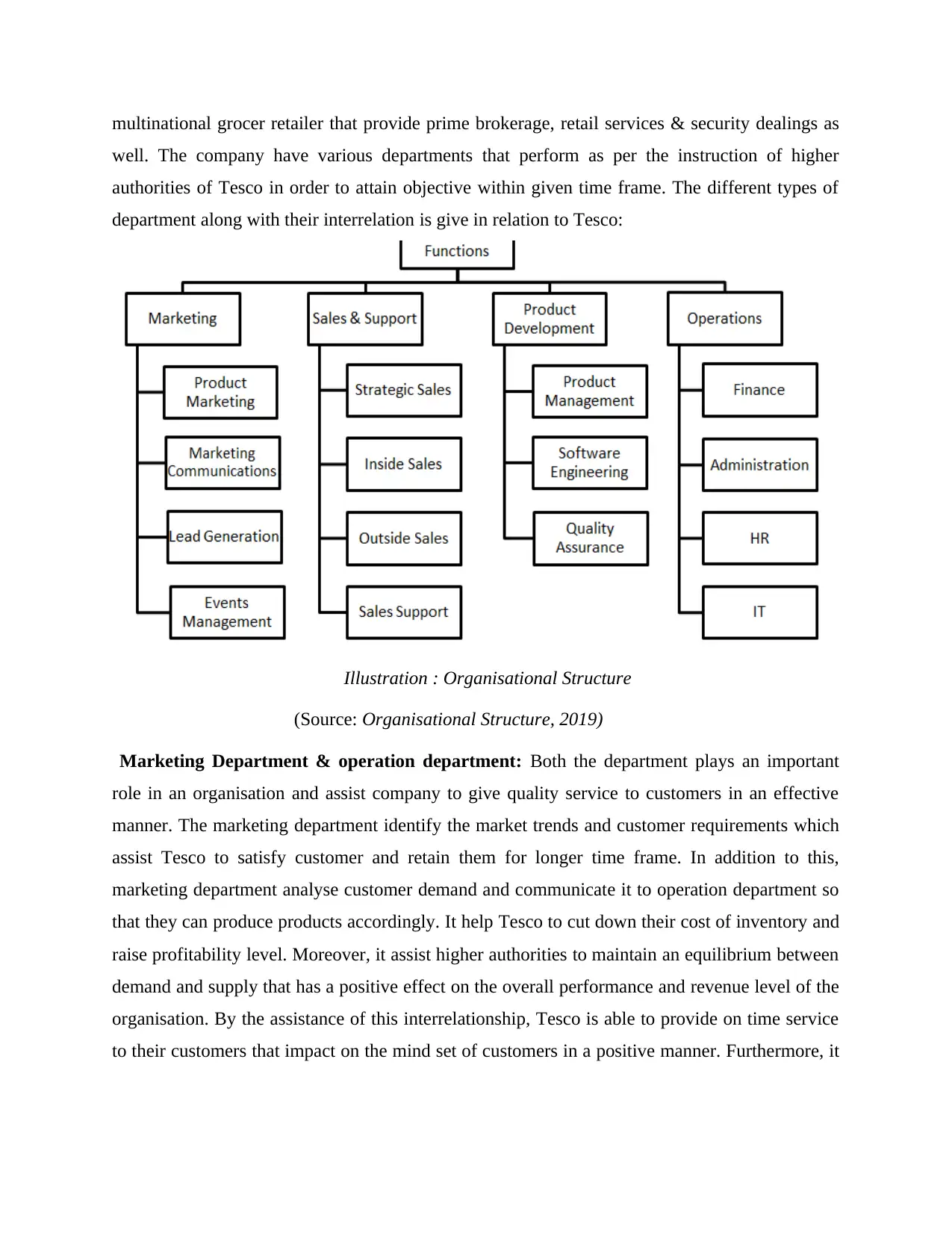
multinational grocer retailer that provide prime brokerage, retail services & security dealings as
well. The company have various departments that perform as per the instruction of higher
authorities of Tesco in order to attain objective within given time frame. The different types of
department along with their interrelation is give in relation to Tesco:
Illustration : Organisational Structure
(Source: Organisational Structure, 2019)
Marketing Department & operation department: Both the department plays an important
role in an organisation and assist company to give quality service to customers in an effective
manner. The marketing department identify the market trends and customer requirements which
assist Tesco to satisfy customer and retain them for longer time frame. In addition to this,
marketing department analyse customer demand and communicate it to operation department so
that they can produce products accordingly. It help Tesco to cut down their cost of inventory and
raise profitability level. Moreover, it assist higher authorities to maintain an equilibrium between
demand and supply that has a positive effect on the overall performance and revenue level of the
organisation. By the assistance of this interrelationship, Tesco is able to provide on time service
to their customers that impact on the mind set of customers in a positive manner. Furthermore, it
well. The company have various departments that perform as per the instruction of higher
authorities of Tesco in order to attain objective within given time frame. The different types of
department along with their interrelation is give in relation to Tesco:
Illustration : Organisational Structure
(Source: Organisational Structure, 2019)
Marketing Department & operation department: Both the department plays an important
role in an organisation and assist company to give quality service to customers in an effective
manner. The marketing department identify the market trends and customer requirements which
assist Tesco to satisfy customer and retain them for longer time frame. In addition to this,
marketing department analyse customer demand and communicate it to operation department so
that they can produce products accordingly. It help Tesco to cut down their cost of inventory and
raise profitability level. Moreover, it assist higher authorities to maintain an equilibrium between
demand and supply that has a positive effect on the overall performance and revenue level of the
organisation. By the assistance of this interrelationship, Tesco is able to provide on time service
to their customers that impact on the mind set of customers in a positive manner. Furthermore, it
⊘ This is a preview!⊘
Do you want full access?
Subscribe today to unlock all pages.

Trusted by 1+ million students worldwide
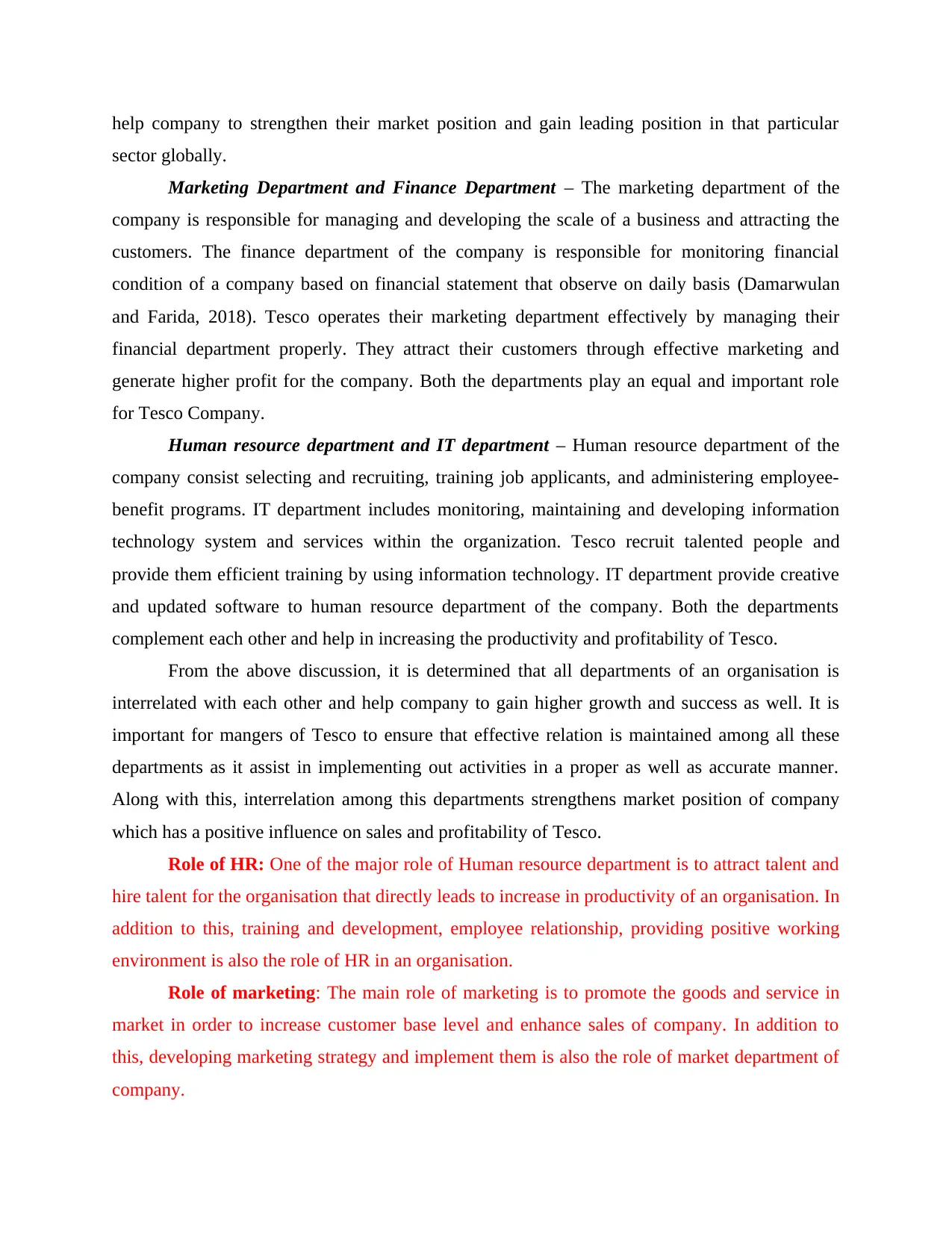
help company to strengthen their market position and gain leading position in that particular
sector globally.
Marketing Department and Finance Department – The marketing department of the
company is responsible for managing and developing the scale of a business and attracting the
customers. The finance department of the company is responsible for monitoring financial
condition of a company based on financial statement that observe on daily basis (Damarwulan
and Farida, 2018). Tesco operates their marketing department effectively by managing their
financial department properly. They attract their customers through effective marketing and
generate higher profit for the company. Both the departments play an equal and important role
for Tesco Company.
Human resource department and IT department – Human resource department of the
company consist selecting and recruiting, training job applicants, and administering employee-
benefit programs. IT department includes monitoring, maintaining and developing information
technology system and services within the organization. Tesco recruit talented people and
provide them efficient training by using information technology. IT department provide creative
and updated software to human resource department of the company. Both the departments
complement each other and help in increasing the productivity and profitability of Tesco.
From the above discussion, it is determined that all departments of an organisation is
interrelated with each other and help company to gain higher growth and success as well. It is
important for mangers of Tesco to ensure that effective relation is maintained among all these
departments as it assist in implementing out activities in a proper as well as accurate manner.
Along with this, interrelation among this departments strengthens market position of company
which has a positive influence on sales and profitability of Tesco.
Role of HR: One of the major role of Human resource department is to attract talent and
hire talent for the organisation that directly leads to increase in productivity of an organisation. In
addition to this, training and development, employee relationship, providing positive working
environment is also the role of HR in an organisation.
Role of marketing: The main role of marketing is to promote the goods and service in
market in order to increase customer base level and enhance sales of company. In addition to
this, developing marketing strategy and implement them is also the role of market department of
company.
sector globally.
Marketing Department and Finance Department – The marketing department of the
company is responsible for managing and developing the scale of a business and attracting the
customers. The finance department of the company is responsible for monitoring financial
condition of a company based on financial statement that observe on daily basis (Damarwulan
and Farida, 2018). Tesco operates their marketing department effectively by managing their
financial department properly. They attract their customers through effective marketing and
generate higher profit for the company. Both the departments play an equal and important role
for Tesco Company.
Human resource department and IT department – Human resource department of the
company consist selecting and recruiting, training job applicants, and administering employee-
benefit programs. IT department includes monitoring, maintaining and developing information
technology system and services within the organization. Tesco recruit talented people and
provide them efficient training by using information technology. IT department provide creative
and updated software to human resource department of the company. Both the departments
complement each other and help in increasing the productivity and profitability of Tesco.
From the above discussion, it is determined that all departments of an organisation is
interrelated with each other and help company to gain higher growth and success as well. It is
important for mangers of Tesco to ensure that effective relation is maintained among all these
departments as it assist in implementing out activities in a proper as well as accurate manner.
Along with this, interrelation among this departments strengthens market position of company
which has a positive influence on sales and profitability of Tesco.
Role of HR: One of the major role of Human resource department is to attract talent and
hire talent for the organisation that directly leads to increase in productivity of an organisation. In
addition to this, training and development, employee relationship, providing positive working
environment is also the role of HR in an organisation.
Role of marketing: The main role of marketing is to promote the goods and service in
market in order to increase customer base level and enhance sales of company. In addition to
this, developing marketing strategy and implement them is also the role of market department of
company.
Paraphrase This Document
Need a fresh take? Get an instant paraphrase of this document with our AI Paraphraser
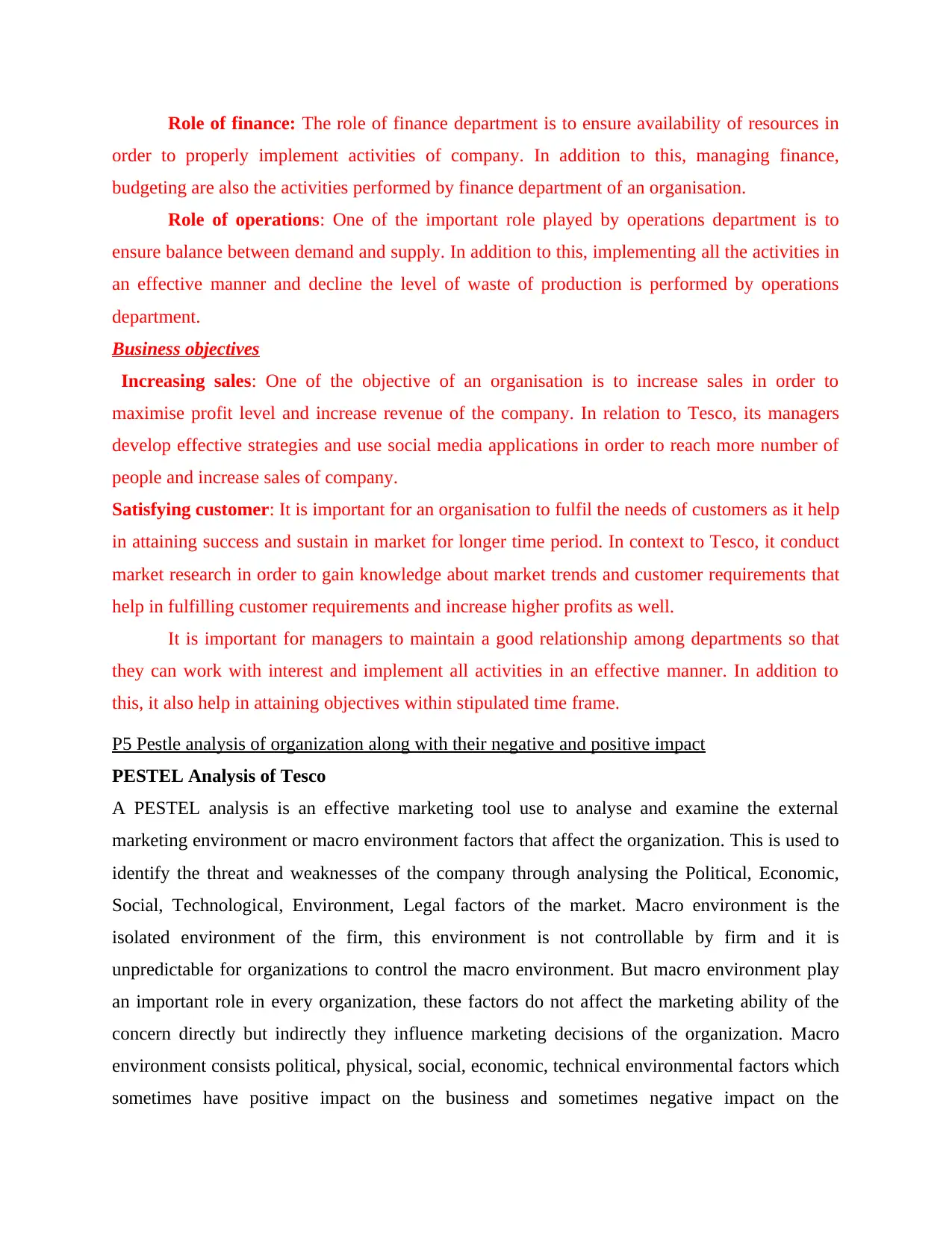
Role of finance: The role of finance department is to ensure availability of resources in
order to properly implement activities of company. In addition to this, managing finance,
budgeting are also the activities performed by finance department of an organisation.
Role of operations: One of the important role played by operations department is to
ensure balance between demand and supply. In addition to this, implementing all the activities in
an effective manner and decline the level of waste of production is performed by operations
department.
Business objectives
Increasing sales: One of the objective of an organisation is to increase sales in order to
maximise profit level and increase revenue of the company. In relation to Tesco, its managers
develop effective strategies and use social media applications in order to reach more number of
people and increase sales of company.
Satisfying customer: It is important for an organisation to fulfil the needs of customers as it help
in attaining success and sustain in market for longer time period. In context to Tesco, it conduct
market research in order to gain knowledge about market trends and customer requirements that
help in fulfilling customer requirements and increase higher profits as well.
It is important for managers to maintain a good relationship among departments so that
they can work with interest and implement all activities in an effective manner. In addition to
this, it also help in attaining objectives within stipulated time frame.
P5 Pestle analysis of organization along with their negative and positive impact
PESTEL Analysis of Tesco
A PESTEL analysis is an effective marketing tool use to analyse and examine the external
marketing environment or macro environment factors that affect the organization. This is used to
identify the threat and weaknesses of the company through analysing the Political, Economic,
Social, Technological, Environment, Legal factors of the market. Macro environment is the
isolated environment of the firm, this environment is not controllable by firm and it is
unpredictable for organizations to control the macro environment. But macro environment play
an important role in every organization, these factors do not affect the marketing ability of the
concern directly but indirectly they influence marketing decisions of the organization. Macro
environment consists political, physical, social, economic, technical environmental factors which
sometimes have positive impact on the business and sometimes negative impact on the
order to properly implement activities of company. In addition to this, managing finance,
budgeting are also the activities performed by finance department of an organisation.
Role of operations: One of the important role played by operations department is to
ensure balance between demand and supply. In addition to this, implementing all the activities in
an effective manner and decline the level of waste of production is performed by operations
department.
Business objectives
Increasing sales: One of the objective of an organisation is to increase sales in order to
maximise profit level and increase revenue of the company. In relation to Tesco, its managers
develop effective strategies and use social media applications in order to reach more number of
people and increase sales of company.
Satisfying customer: It is important for an organisation to fulfil the needs of customers as it help
in attaining success and sustain in market for longer time period. In context to Tesco, it conduct
market research in order to gain knowledge about market trends and customer requirements that
help in fulfilling customer requirements and increase higher profits as well.
It is important for managers to maintain a good relationship among departments so that
they can work with interest and implement all activities in an effective manner. In addition to
this, it also help in attaining objectives within stipulated time frame.
P5 Pestle analysis of organization along with their negative and positive impact
PESTEL Analysis of Tesco
A PESTEL analysis is an effective marketing tool use to analyse and examine the external
marketing environment or macro environment factors that affect the organization. This is used to
identify the threat and weaknesses of the company through analysing the Political, Economic,
Social, Technological, Environment, Legal factors of the market. Macro environment is the
isolated environment of the firm, this environment is not controllable by firm and it is
unpredictable for organizations to control the macro environment. But macro environment play
an important role in every organization, these factors do not affect the marketing ability of the
concern directly but indirectly they influence marketing decisions of the organization. Macro
environment consists political, physical, social, economic, technical environmental factors which
sometimes have positive impact on the business and sometimes negative impact on the
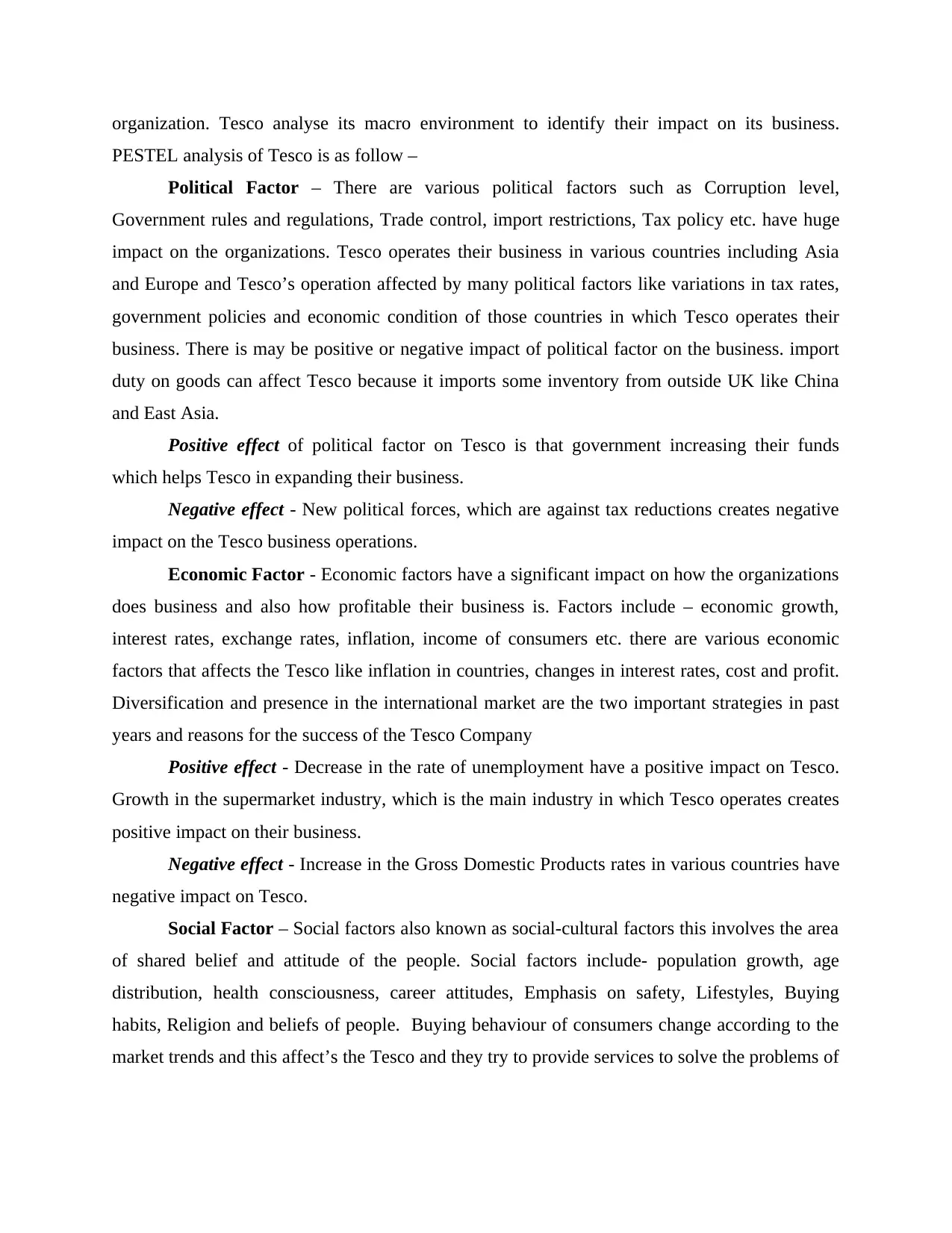
organization. Tesco analyse its macro environment to identify their impact on its business.
PESTEL analysis of Tesco is as follow –
Political Factor – There are various political factors such as Corruption level,
Government rules and regulations, Trade control, import restrictions, Tax policy etc. have huge
impact on the organizations. Tesco operates their business in various countries including Asia
and Europe and Tesco’s operation affected by many political factors like variations in tax rates,
government policies and economic condition of those countries in which Tesco operates their
business. There is may be positive or negative impact of political factor on the business. import
duty on goods can affect Tesco because it imports some inventory from outside UK like China
and East Asia.
Positive effect of political factor on Tesco is that government increasing their funds
which helps Tesco in expanding their business.
Negative effect - New political forces, which are against tax reductions creates negative
impact on the Tesco business operations.
Economic Factor - Economic factors have a significant impact on how the organizations
does business and also how profitable their business is. Factors include – economic growth,
interest rates, exchange rates, inflation, income of consumers etc. there are various economic
factors that affects the Tesco like inflation in countries, changes in interest rates, cost and profit.
Diversification and presence in the international market are the two important strategies in past
years and reasons for the success of the Tesco Company
Positive effect - Decrease in the rate of unemployment have a positive impact on Tesco.
Growth in the supermarket industry, which is the main industry in which Tesco operates creates
positive impact on their business.
Negative effect - Increase in the Gross Domestic Products rates in various countries have
negative impact on Tesco.
Social Factor – Social factors also known as social-cultural factors this involves the area
of shared belief and attitude of the people. Social factors include- population growth, age
distribution, health consciousness, career attitudes, Emphasis on safety, Lifestyles, Buying
habits, Religion and beliefs of people. Buying behaviour of consumers change according to the
market trends and this affect’s the Tesco and they try to provide services to solve the problems of
PESTEL analysis of Tesco is as follow –
Political Factor – There are various political factors such as Corruption level,
Government rules and regulations, Trade control, import restrictions, Tax policy etc. have huge
impact on the organizations. Tesco operates their business in various countries including Asia
and Europe and Tesco’s operation affected by many political factors like variations in tax rates,
government policies and economic condition of those countries in which Tesco operates their
business. There is may be positive or negative impact of political factor on the business. import
duty on goods can affect Tesco because it imports some inventory from outside UK like China
and East Asia.
Positive effect of political factor on Tesco is that government increasing their funds
which helps Tesco in expanding their business.
Negative effect - New political forces, which are against tax reductions creates negative
impact on the Tesco business operations.
Economic Factor - Economic factors have a significant impact on how the organizations
does business and also how profitable their business is. Factors include – economic growth,
interest rates, exchange rates, inflation, income of consumers etc. there are various economic
factors that affects the Tesco like inflation in countries, changes in interest rates, cost and profit.
Diversification and presence in the international market are the two important strategies in past
years and reasons for the success of the Tesco Company
Positive effect - Decrease in the rate of unemployment have a positive impact on Tesco.
Growth in the supermarket industry, which is the main industry in which Tesco operates creates
positive impact on their business.
Negative effect - Increase in the Gross Domestic Products rates in various countries have
negative impact on Tesco.
Social Factor – Social factors also known as social-cultural factors this involves the area
of shared belief and attitude of the people. Social factors include- population growth, age
distribution, health consciousness, career attitudes, Emphasis on safety, Lifestyles, Buying
habits, Religion and beliefs of people. Buying behaviour of consumers change according to the
market trends and this affect’s the Tesco and they try to provide services to solve the problems of
⊘ This is a preview!⊘
Do you want full access?
Subscribe today to unlock all pages.

Trusted by 1+ million students worldwide
1 out of 20
Related Documents
Your All-in-One AI-Powered Toolkit for Academic Success.
+13062052269
info@desklib.com
Available 24*7 on WhatsApp / Email
![[object Object]](/_next/static/media/star-bottom.7253800d.svg)
Unlock your academic potential
Copyright © 2020–2025 A2Z Services. All Rights Reserved. Developed and managed by ZUCOL.





